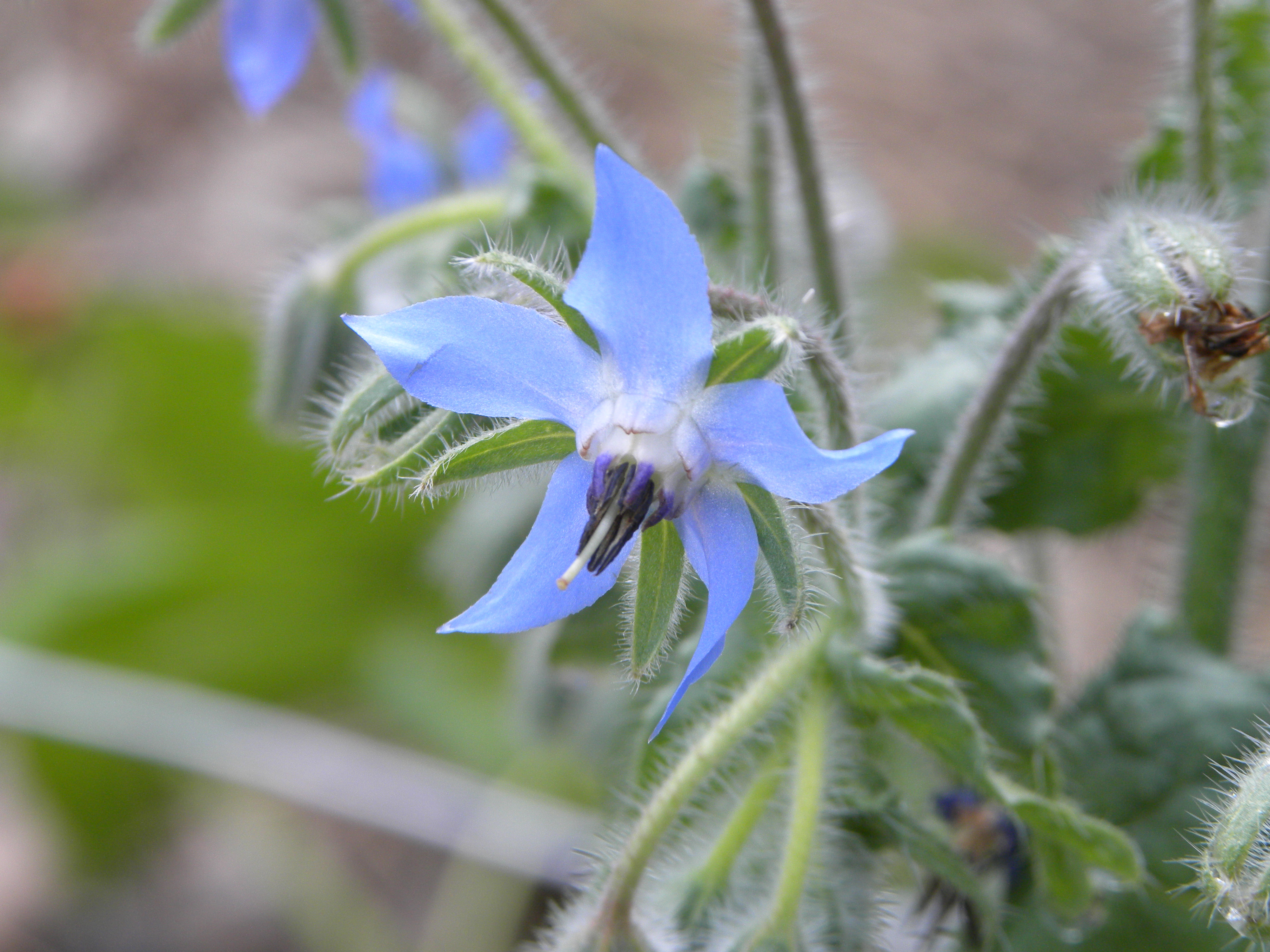
Borage Flower
June is one of my favorite months. Warm but not too hot, hearing bird song, frog song and breezes in the leafed-out trees, witnessing the plants grow, the animals thrive and the fireflies flashing at night. The downside is the number of biting insects! Insects do speak to the health of the environment, though, and with the modern invention of window screening, we can escape them when needed.
So, even though there is a ton of work to do, I make sure to stop and appreciate living in this beautiful place.
This particular June, weather conditions weren’t ideal for growing, being mostly cooler than usual and having little rain. On June 1 NH was drought-free, but as of June 26 all of Strafford county NH was classified as in a “moderate” drought. However, cool and dry is excellent working weather and we had lots to do!
Our Work in June
Outdoors: Plants
June brings us the longest day of the year, which means there is plenty of light for working outside, early and late. I often feel this time of year like when I’m not planting or tending the plants I am losing out on future harvest. It makes it hard to remain calm for all the other parts of life needing attention! That’s a good time to practice appreciation, as I mentioned above.
Planting continued. Very early in the month, I planted 25 eggplant seedlings, of three varieties: Purple Pickling, Nadia and Diamond. This used one bed in the main annual garden, plus I placed some in the front orchard. I reseeded winter squash varieties and cucumbers that hadn’t germinated well. In our newest hugel area I seeded melons (Escorial, Montreal Market, Savor), more Delicata and Butternut squash, and cover crops of Japanese
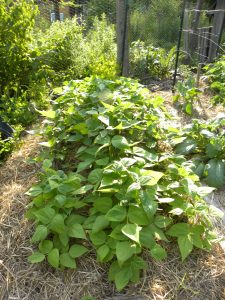
Bush Beans
Millet and Japanese Buckwheat. Steve drove more stakes and ran wire so I could plant more climbing beans: Turkey Craw and Good Mother Stallard. I also seeded another area of Pinto beans. Mid-month I planted more root crops: Andover parsnip (it was actually a little late to start them), various carrots and beets. I had been late starting my basil indoors, so I gave that a good long time in the greenhouse before transplanting it on June 24. At that time, I also started my next round of bush beans.
I covered the eggplant and basil with row cover for a little extra heat retention since they love heat and it wasn’t a consistently warm month.
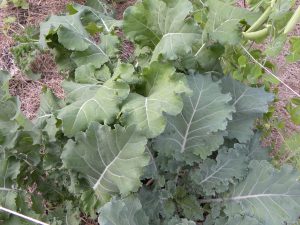
Kale getting crowded
Most of my crops are looking good so far. My earliest root crop plantings germinated poorly – maybe because of too low soil temps? It’s very frustrating to carefully hand sow those tiny carrot seeds with poor results. Heat lovers like tomatoes and eggplant grew slowly without much heat. My brassicas, beans, potatoes, leeks and squash look gorgeous! No disease or insect problems to speak of so far this season, although I am starting to see white imported cabbageworm moths fluttering about!
With the drought, there was watering to do for all the newly planted crops. The rain barrels empty quickly in these conditions. The ponds last longer, especially the one fed from our overflowing wellhead. We mostly did spot watering rather than using automated systems. It takes time, but is the most efficient in terms of water use.
We also brought in materials (hay, wood chips, cardboard) to mulch with for moisture retention and soil health. In many places the mulch had gotten thin, being digested by the soil. That’s great – we just need to remember to refresh it.
Speaking of feeding soil, Steve continues to experiment with diluted urine as fertilizer, especially on our alternate pasture areas. After the animals eat the vegetation down to the ground, we fence it off again and he fertilizes. He managed to overdo it in one area so we saw what “burning” the plants looks like. Other than that, it’s going well as far as we can see and smell. The grass is truly greener. Steve is also preparing to launch a line of urine diverting “toilets” for sale soon!
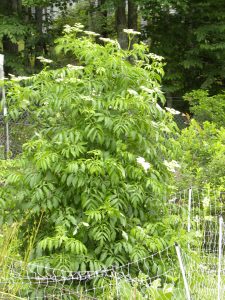
Our elderberry bush is 10 feet tall and spreading – the goats love the leaves I prune off
I have done quite a bit of what I guess we can call weeding. Because of how much I mulch, my established and annual gardens have almost no weeds. Where we are expanding, though, there are plants to cut back, often resprouting from stumps. Also, in the orchards, I am trying to get particular plants established as the layers of mulch break down. The best ground covering is always plants. At this point, I still need to go through and pull what I don’t want there (wild lettuce, thistle, pigweed, bindweed, crabgrass, brambles, excess mullein, chickweed and plantain) to make space for the spread of my chosen species (red clover, lupine, dandelion, calendula, echinacea, borage, cleome, globe thistle, angelica, valerian, nettles, and comfrey). At a certain point, even these need to be hacked back in order not to affect my food crops.
Everything that I take out, with scything, pruning or hand pulling, goes to the goats. It is very satisfying to watch them devour what otherwise seemed like waste. Well, it would have been composted or used for mulch, but still – it feels even better to turn it into milk!
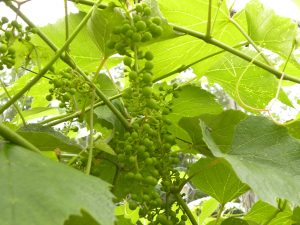
Grapes Developing
Other miscellaneous work included tending grape vines, adding wires forpole beans, digging up and replanting some perennials, thinning the peaches, gathering manure and seaweed to create new growing areas.
Outdoors: Animals

Chicks in Tractor
The chicks that hatched last month from Steve’s DIY incubator grew quickly in the brooder and were moved outside mid-June to a chicken tractor. They were especially excited to start roosting versus sleeping on the floor. They quickly learned to love eating plants and bugs, scratching on the ground, and dust bathing as well. Strangely, from what I can tell, we have 11 female and 1 male in this batch. We’ve never had such an unbalanced gender percentage – I have no idea what that might mean, if anything!
Our big excitement with goats this month was Lily’s trip to the vet (video here: Lily Goes to the Vet). Every year we bring one of our goats to be tested for: CAE, CL, Johne’s, selenium deficiency, TB and brucellosis. We have never had reason to think we have these, but they are serious issues and regular testing is important to keep up, especially if selling animals. In fact, we implore people not to bring home goats from untested herds or breed to an untested buck. Always ask for copies of paperwork first!
Steve repaired and added more fencing, to keep in our livestock and to exclude predators. I am happy to report few losses so far this year. We’ve
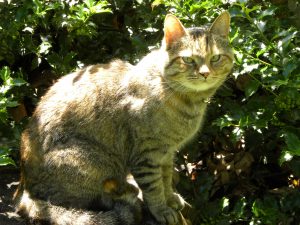
Tabitha… her belled collar stops her from catching birds
rarely lost animals, but some years groundhog and deer have wreaked havoc on our poor plants. This year I can really only complain about the chipmunks. What destructive little beasts they can be! We are indebted to our huntress, Tabitha the cat, for keeping all our rodents in check to some extent at least.
My two hives are doing fine, but aren’t impressing me. Both have cranky personalities and aren’t growing very quickly. I plan to replace these queens with northern stock in July.
Indoors
Unfortunately, our second round of egg incubation was unsuccessful. We’d set both chicken and duck eggs. Just one of each hatched, and neither lived beyond a few days. It was disappointing and sad. Steve is investigating and reading and thinks that the temps got too high this time around. He has some new designs to try next year, and we also plan to buy another incubator. The commercially made ones do work, they just break down much faster than we approve of.
The other possible issue, although less likely, is that we haven’t replaced our rooster or drake for a few years so some inbreeding could be impacting our hatch rates. There isn’t much evidence of this being our problem and birds can tolerate quite a bit of inbreeding, but it did motivate us to reach out to find new stock. We don’t have connections to many others working with our
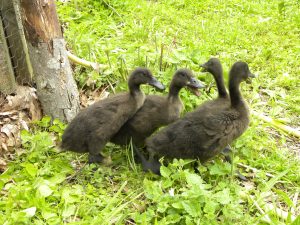
Indian Runner Ducklings
breeds of poultry, so I searched not-quite-frantically online. We found nice folks in Pelham NH with four black Indian Runner ducklings, old enough to move right outside rather than deal with brooding them in my tub (video here: New Indian Runner Ducklings – June 2018). Now we just have to hope there is a male in the batch. It will be a few months before we can tell gender. Then I tracked down a woman breeding Dominique chickens only a few towns over from me at Just A Notion Exhibition Poultry. In fact, she shows at the Deerfield Fair and we bought our last rooster from her, without ever meeting. She’ll be a great resource for information and help as well as new stock. Phew!
Open Homestead
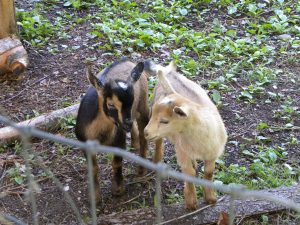
The twins entertained at our Open Homestead Day
On June 2 we held our first Open Homestead Day. We had some big goals for organizing ahead of time that we mostly met. We so enjoyed showing people around and reflecting on our decade here and future plans. It was especially gratifying to have some friends come who hadn’t been here for awhile and could remind us of how much had changed. It’s hard to notice progress happening over years without such a reality check.
Off-farm
Since most people don’t live by an agricultural calendar at the moment, plenty of activities continue as summer arrives (not schools or the NH Legislature, which still follow a farming schedule!). I did spend time off-farm even though I limited my commitments. I was glad to make it to a few NH Peace Action events, our True Tales Live storytelling workshop and performance, and even to the SoBo Story Slam at The Sarah Orne Jewett House in Maine. I told my Bee Moving story there, and met another serious organic gardener, Mort Mather, whose book, Gardening for Independence, I am now greatly enjoying.
We also went strawberry picking at East Wind Farm since we don’t grow enough here for our appetites. They have amazing organic berries. I’ve put 5 gallon bags into the freezer, which I’ll process into preserves and jelly when the cooler weather arrives this fall.
June’s Harvest
We brought in 155 chicken eggs, 70 duck eggs, and 11.1 gallons of milk.
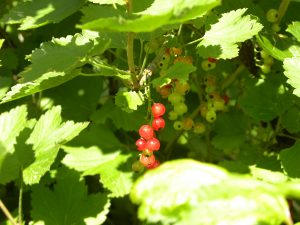
Red Currants Ripening
From the garden we brought in: 5 heads of lettuce, 7 pounds of rhubarb, 95 garlic scapes, 10 radishes, 1 pound of kale & collard leaves. Plus, “handfuls” of: oregano, garlic chives, chives, sorrel, mint, peas, honeyberries, strawberries, red currants and blueberries.
From previous years, the garlic ran out this month – just in time to start eating the garlic scapes. Still remaining: honey, canned peaches, blueberries and strawberry jelly, dried kale and beans, frozen eggplant, pesto, and salsa.
We grew fodder for the animals as well, many kinds, some tossed to them and some we let them pick themselves by using portable electric fencing.
We made 550 kwh from the PV solar panels. You’ll notice this is less than the past couple of months because, despite even more sun, the trees leafing out reduced how much sun reached the panels. It is still more than we used, so our “carry forward” account with the power company is growing.
I am also moved to put in the harvest column: beauty and rewarding work!
Looking Ahead
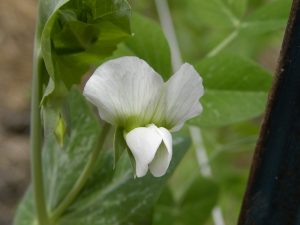
Pea Flower
There is plenty on my to-do list coming up. Here’s a sampling: hill potatoes, train beans and grapes, more sheet mulching, trim overgrowing trees, repair shed, cut problem weeds before they go to seed, successive plantings of root crops and beans, and learning to make frozen yogurt or ice cream/milk. And, soon, harvesting and food preservation will take much of my time, I hope! I can already see peas, beans and more berries forming.
July’s weather forecast is predicting seasonably hot and humid conditions coming up, which will slow down the heavier work. Thus, there will be some time to catch up on email, reading, and writing.
I’ll close this entry with a quote that speaks to this time of year for me: “The earth loves us back in beans and corn and strawberries.” -Robin Wall Kimmerer

